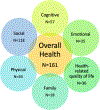Overall Health Following Pediatric Critical Illness: A Scoping Review of Instruments and Methodology
- PMID: 34261948
- PMCID: PMC8639621
- DOI: 10.1097/PCC.0000000000002800
Overall Health Following Pediatric Critical Illness: A Scoping Review of Instruments and Methodology
Abstract
Objectives: Families identify overall health as a key outcome after pediatric critical illness. We conducted a planned secondary analysis of a scoping review to determine the methods, populations, and instruments used to evaluate overall health outcomes for both children and their families after critical illness.
Design: Planned Secondary Analysis of a Scoping Review.
Setting: We searched PubMed, EMBASE, PsycINFO, Cumulative Index of Nursing and Allied Health Literature, and the Cochrane Controlled Trials Registry databases from 1970 to 2017 to identify studies which measured postdischarge overall health of children who survived critical illness and their families.
Subjects: Articles reporting overall health outcomes after pediatric critical illness.
Interventions: None.
Measurements and main results: Among the 407 articles which measured outcomes following pediatric critical illness, 161 (40%) measured overall health. The overall health domain was most commonly measured in traumatic brain injury (44%) and the general PICU populations (16%). In total, there were 39 unique measures used to evaluate overall health. Across all subjects, seven measures accounted for 89% of instruments, with the Glasgow Outcome Scale (47%) and the Pediatric Overall Performance Category (17%) being most commonly used. Excluding studies targeting survivors of traumatic brain injury, Pediatric Overall Performance Category, Glasgow Outcome Scale, and the General Health Questionnaire were the most commonly used instruments. Patients were followed for a median 10.5 months (interquartile range, 4.5-21 mo).
Conclusions: Overall health was commonly assessed post-PICU discharge, especially in the traumatic brain injury population, using a heterogenous array of measures. Evaluation and consensus are imperative to identify the most appropriate method to measure overall health with the goal of improving care efficacy and facilitating recovery across populations of critically ill children.
Copyright © 2021 by the Society of Critical Care Medicine and the World Federation of Pediatric Intensive and Critical Care Societies.
Conflict of interest statement
Drs. Carlton, Fink, Ringwood, and Maddux received support for article research from the National Institutes of Health (NIH). Drs. Fink’s, Ringwood’s, and Maddux’s institutions received funding from the NIH. Drs. Ringwood’s and Maddux’s institutions received funding from the National Institute of Child Health and Human Development. Dr. Ringwood received funding from employment by contracted data coordinating center; she disclosed work for hire. Dr. Maddux’s institution received funding from the Francis Family Foundation. The remaining authors have disclosed that they do not have any potential conflicts of interest. The content is solely the responsibility of the authors and does not necessarily represent the official views of the National Institutes of Health. The remaining authors have disclosed that they do not have any conflicts of interest.
Figures


References
-
- Pinto NP, Rhinesmith EW, Kim TY, et al.: Long-Term Function After Pediatric Critical Illness. Pediatr Crit Care Med 2017; 18:e122–e130 - PubMed
-
- Manning JC, Pinto NP, Rennick JE, et al.: Conceptualizing Post Intensive Care Syndrome in Children-The PICS-p Framework Pediatr Crit Care Med 2018; 19:298–300 - PubMed
-
- Watson RS, Choong K, Colville G, et al.: Life after Critical Illness in Children-Toward an Understanding of Pediatric Post-intensive Care Syndrome. J Pediatrics 2018; 198:16–24 - PubMed
Publication types
MeSH terms
Grants and funding
LinkOut - more resources
Full Text Sources

